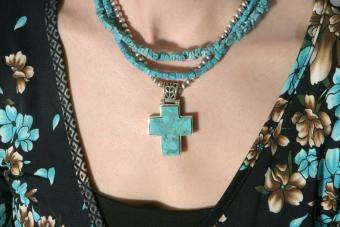
Bakelite created a sensation when it was first developed and was once used in everything from radios to tables, but Bakelite bracelets are in most demand among collectors and jewelry lovers.
About Bakelite
Bakelite was the trade name given to phenol formaldehyde, the first synthetic plastic ever developed. In 1907, scientist Leo Baekeland was searching for a better insulation material for electric appliances and other items when he created Bakelite. In the 1930s, manufacturers used this versatile plastic to bring color to America's kitchens for the first time by creating kitchen tools in colors like blue and red instead of the traditional brown and black. It was also adopted by jewelry makers who recognized how brightly colored, inexpensive jewelry would appeal to Depression Era women.
Styles of Bakelite Bracelets
There are a number of designs on the market for Bakelite bracelets, which are available in all the colors of the rainbow as well as neutrals.
Solid bangle bracelets are very common, but link bracelets are also available. The Bakelite is sometimes carved with geometric designs or with flowers and leaves. Some are narrow while others are wide; some are thick and others thin. With so many choices, there's bound to be something to please most tastes.
In general, the thicker, more intricately carved bracelets are more sought after (and more expensive). However, even simple Bakelite bangles are sometimes hard to find, especially in rarer colors. Translucent red is in high demand in any style of Bakelite item.

Recognizing Genuine Bakelite
It can be difficult to distinguish genuine Bakelite from reproductions, so it is important to buy only from reputable dealers. Again, educating yourself about Bakelite jewelry will make you more familiar with the styles on the market and help you to spot a fake when it shows up. There are a few tried-and-true ways to tell real Bakelite from fake.
- Look for places where the color has rubbed off showing white plastic underneath - that's a sign of a fake. Bakelite will retain its color throughout the entire piece.
- True Bakelite should not show any seams from the molding process because they were removed before the product left the factory.
- Put the bracelet in hot water - when it is removed it should smell strongly of formaldehyde. That's one of the best tests for Bakelite, but unfortunately, it's not practical to do it in an antique shop. As an alternative, some experts recommend rubbing the piece briskly until it's warm and then trying to detect a formaldehyde scent.
Bakelite Bracelet Pricing
Bakelite bracelets can range from less than ten dollars to several hundred, even thousands, depending on the condition and rarity of the piece.
It's important to be able to distinguish between low and high priced Bakelite so you don't wind up paying premium prices for a cheap bracelet. Before buying, attempt to determine whether the asking price is fair by searching for similar pieces on the internet and consulting buyer's guides.
If you're a collector, try to find out as much as you can about Bakelite before buying since educating yourself is the best way to avoid being taken advantage of. By looking at and handling many different kinds of Bakelite bracelets, you'll learn to recognize the traits of the more costly pieces and you'll have a better idea of what price ought to be paid for a particular bracelet.
Where to Buy Bakelite Bracelets
Bakelite bracelets can often be found where antiques and collectibles are sold. Check out antiques shops, antiques malls, antiques auctions and estate sales in your area to see if you come across Bakelite bracelets.
Alternatively, head for the internet. Your best bet will be with sites that specialize in antique and vintage items, particularly jewelry.
Caring for Bakelite Bracelets
Bakelite bracelets, as well as other Bakelite jewelry, should be stored out of direct light and extreme temperatures.
Cleaning Bakelite should also be done carefully. Bakelite develops a patina over time, and this adds to both the sense of history and the value of the pieces.
- Make a weak washing solution of dish detergent and warm water.
- Gently wash the bracelets with a soft cotton cloth.
- Using a second cloth dipped in clean water, rinse any soap from the bracelet.
- Dry the bracelet with a clean, dry cotton cloth. If it has an intricate design and it's not easy to get into all of the crevices, let it air dry on a cloth.
It is also worth noting that Bakelite can break and crack if it's dropped or banged around too much, so you'll want to be careful when wearing it.

Never Out of Style
Bakelite bracelets are a classic for a reason. They're beautiful, durable, and a reminder of a period in our history when plastic was new and novel. With proper care, they'll last for generations to come.







